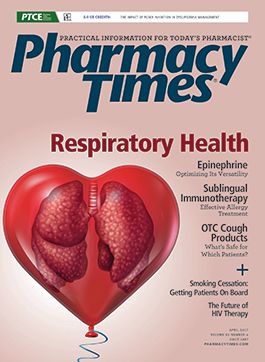Publication
Article
Pharmacy Times
Epinephrine: Optimizing Its Versatility
Author(s):
Epinephrine, also known as “adrenaline,” is a hormone, a neurotransmitter, and a medication.
Epinephrine, also known as “adrenaline,” is a hormone, a neurotransmitter, and a medication. Produced by both the adrenal glands and certain neurons, epinephrine is one of the most important hormones to the fight-or-flight response, acting on the alpha and beta receptors to increase blood flow to muscles, increase output of the heart, dilate the pupils, and increase the blood glucose level.
As a medication, epinephrine is used to treat anaphylaxis, cardiac arrest, and superficial bleeding. Other possible indications are to help treat croup, emphysema, and asthma. Epinephrine can be administered intravenously, intramuscularly, subcutaneously, or by inhalation.1
Physiologic Response
Aerobic exercise stimulates epinephrine secretion in proportion to the intensity of the exercise. Anaerobic exercise results in even greater concentration increases.2 The Table3 lists the physiologic responses associated with various epinephrine concentrations.2 Epinephrine also may intensify feelings of fear, but does not seem to affect anger and amusement.3

Mechanism of Action
Epinephrine is a nonselective agonist and includes the major subtypes alpha1, alpha2, beta1, beta2, and beta3. By binding to alpha-adrenergic receptors, it decreases insulin production and stimulates glucagon secretion by the pancreas, as well as stimulates glycogenolysis by the liver and muscles. Epinephrine also increases lipolysis by adipose tissue and increases adrenocorticotropic hormone by the pituitary gland. These effects increase the levels of blood glucose and fatty acids, reduce peripheral circulation, and increase coronary and cerebral perfusion pressures.4
Epinephrine Inhalation
Because of its bronchodilation properties, epinephrine inhalation is used to treat wheezing, shortness of breath, and chest tightness associated with asthma, emphysema, and croup.5
Epinephrine Injection
Through its cardiostimulating and bronchodilating effects, epinephrine injection is used in combination with other emergency treatments for anaphylaxis and heart failure. This injection is available by prescription for treating severe allergic reaction.
Drug Interactions
Epinephrine has several drug interactions and should be administered cautiously in patients taking certain medications. Concomitant use with halogenated hydrocarbon general anesthesia, such as halothane, may result in arrhythmias. Tricyclic antidepressants, monoamine oxidase inhibitors, levothyroxine sodium, and certain antihistamines, such as diphenhydramine, tripelennamine, and dexchlorpheniramine potentiate its effects. Beta-adrenergic blocking agents, such as propranolol, antagonize the cardiostimulating and bronchodilating effects. Alpha-adrenergic blocking agents, such as phentolamine, antagonize the vasoconstricting and hypertensive effects. And ergot alkaloids can reverse the pressor effects of epinephrine, which may further lower blood pressure. Therefore, epinephrine should not be used to counteract hypotension or circulatory collapse.6
Adverse Effects
Injection site reactions include bleeding, blistering, burning, coldness, discoloration of the skin, hives, infection, inflammation, itching, lumps, numbness, pain, rash, redness, scarring, soreness, stinging, swelling, tenderness, tingling, ulceration, warmth, or a feeling of pressure.7 Shakiness; trembling in the legs, arms, hands, or feet; and abnormal or decreased touch sensation also can occur. Other adverse effects include blurred vision; dizziness; fainting; fear or nervousness; headache; nausea or vomiting; paleness of the skin; pounding in the ears; restlessness; slow, irregular, or fast heartbeat; stroke; sweating; trouble breathing; unusual tiredness; weakness; chest pain or discomfort; or arm, back, or jaw pain.7
Counseling Points
Patients and their caregivers should know how to use epinephrine pens. An epinephrine injection should be given in the outer thigh at the first sign of severe allergic reaction. The injection can be given through clothing in case of emergency.8 Patients should keep their auto-injectors with them at all times and be advised to keep track of expiration dates and to store the drug at about 77°F. Temperature excursions between 59°F and 86°F are acceptable.9
Most auto-injectors contain enough solution for 1 dose. If symptoms are not relieved or recur after the first dose, another dose might be necessary; however, only a health care provider should give a patient more than 2 doses. Because emergency medical attention is still necessary, patients should go to an emergency department if an auto-injector is used.8
Dr. Kenny earned her doctoral degree from the University of Colorado Health Sciences Center. She has 20+ years’ experience as a community pharmacist and works as a clinical medical writer based out of Colorado Springs, Colorado. Dr. Kenny is also the Colorado Education Director for the Rocky Mountain Chapter of the American Medical Writers Association and a regular contributor to Pharmacy Times®.
References
- EpiPen Injection. WebMD website. http://www.webmd.com/drugs/2/drug-20017/epipen-injection/details#side-effects. Accessed January 8, 2017.
- Physical Exercise: Epinephrine. The University of Mississippi Medical Center website. https://www.umc.edu/Education/Schools/Medicine/Basic_Science/Physiology_and_Biophysics/Core_Facilities(Physiology)/Physical_Exercise_-_Epinephrine.aspx. Accessed January 8, 2017.
- Mezzacappa ES. Epinephrine, arousal, and emotion: a new look at two-factor theory. Cognition Emotion. 1999;13(2):181-199.
- Epinephrine. DrugBank website. https://www.drugbank.ca/drugs/DB00668. Accessed January 8, 2017.
- Epinephrine Inhalation. WebMD website. http://www.webmd.com/drugs/2/drug-21395/epinephrine-inhalation/details. Accessed January 8, 2017.
- Adrenalin drug interactions. RxList website. http://www.rxlist.com/adrenalin-drug/side-effects-interactions.htm. Accessed January 8, 2017.
- Epinephrine side effects. Drugs.com website. https://www.drugs.com/sfx/epinephrine-side-effects.html. Accessed January 8, 2017.
- EpiPen. EpiPen.com website. https://www.epipen.com/hcp/about-epipen/safety-and-storage. Accessed January 8, 2017.







